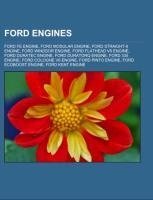
Ford engines
Source: Wikipedia. Pages: 79. Chapters: Ford FE engine, Ford Modular engine, Ford Straight-6 engine, Ford Windsor engine, Ford flathead V8 engine, Ford Duratec engine, Ford Duratorq engine, Ford 335 engine, Ford Cologne V6 engine, Ford Pinto engine, Ford... Viac o knihe
Produkt je dočasne nedostupný
19.71 €
bežná cena: 22.40 €
O knihe
Source: Wikipedia. Pages: 79. Chapters: Ford FE engine, Ford Modular engine, Ford Straight-6 engine, Ford Windsor engine, Ford flathead V8 engine, Ford Duratec engine, Ford Duratorq engine, Ford 335 engine, Ford Cologne V6 engine, Ford Pinto engine, Ford EcoBoost engine, Ford Kent engine, Ford Power Stroke engine, List of Ford engines, Ford SHO V6 engine, Ford Zetec engine, Ford CVH engine, Boss 302 Mustang, Ford Torino Engine Specifications, Ford Essex V6 engine, Ford Barra engine, Ford DLD engine, Ford Sigma engine, Ford Y-block engine, Ford Mondeo V6 engine, Ford AJD-V6/PSA DT17, Ford MEL engine, Ford Cyclone engine, Ford I4 DOHC engine, Ford SHO V8 engine, Ford Boss 302 engine, Ford Taunus V4 engine, Ford Boss engine, Ford Endura-D engine, Ford 385 engine, List of Ford bellhousing patterns, Ford GAA engine, Ford SI6 engine, Ford Model T engine, Ford Vulcan engine, Ford HSC engine, Ford Zeta engine, Ford Sidevalve engine, Ford CHT engine, Renault Ventoux engine, Ford Super Duty engine, Ford Zephyr engine, Ford 4.4 Turbo Diesel, Ford Essex V4 engine, Ford York engine. Excerpt: Connection Timeout The Ford Modular engine is Ford Motor Company's overhead camshaft (OHC) V8 and V10 engine family, which has been produced in 4.6L, 5.0L (Cammer, Coyote), 5.4L, and 6.8L variations. Contrary to popular belief, the Modular engine did not get its name from its design or sharing of certain parts among the engine family. Instead, the name was derived from a manufacturing plant protocol, "Modular", where the plant and its tooling could be changed out in a matter of hours to manufacture different versions of the engine family. The Modular engines are used in various Ford, Lincoln, and Mercury vehicles. Modular engines used in Ford trucks were marketed under the Triton name from 1997-2010 while the InTech name was used for a time at Lincoln for vehicles equipped with DOHC versions of the engines. The engines were first produced in Romeo, Michigan but additional capacity was added in Windsor, Ontario. The 4.6 L (4601 cc, 281 CID) V8 has been offered in 2-valve SOHC, 3-valve SOHC, and 4-valve DOHC versions. The engines were also offered with both aluminum and cast iron blocks, depending on application. The 4.6 L's bore and stroke are nearly square at 90.2 mm (3.552 in) and 90 mm (3.543 in), respectively. Deck height for the 4.6 block is 227 mm (8.937 in) and connecting rod length is 150.7 mm (5.933 in) center to center, giving the 4.6 L a 1.67:1 rod to stroke ratio. Cylinder bore spacing measures 100 mm (3.937 in), which is common to all members of the Modular engine family. All Modular V8s, save for the new 5.0 L Coyote, utilize the same firing order as the Ford 5.0 L HO and 351 CID V8s (1-3-7-2-6-5-4-8). The 4.6 L engines have been assembled at Romeo Engine Plant, located in Romeo, MI, and at Windsor Engine Plant and Essex Engine Plant, both located in Windsor, Ontario. The first production Modular engine was the 4.6 L 2-valve SOHC V8 introduced in the 1991 Lincoln Town Car. The 4.6 L 2V has been built at both Romeo Engine Plant and Windsor Engine Plant,
- Vydavateľstvo: Books LLC, Reference Series
- Formát: Paperback
- Jazyk:
- ISBN: 9781157034469


 Anglický jazyk
Anglický jazyk 
 Nemecký jazyk
Nemecký jazyk 







